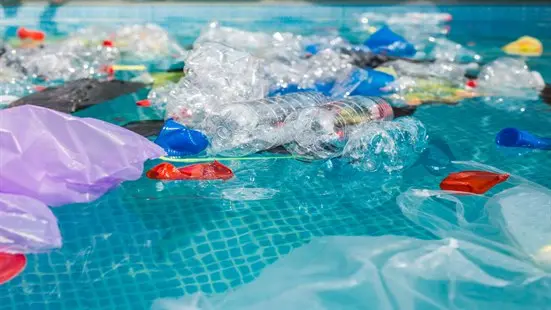Global plastic production is experiencing relentless growth. The subsequent environmental breakdown of this plastic into microplastics now poses a significant and emerging threat to human health.
A recent article in JAMA (Journal of the American Medical Association) provides a timely overview of the scale of plastic production and the consequences of plastic pollution [1]. The data reveals a stark upward trend: in 2000, global production was 234 million tons. By 2020, this figure had surged to 435 million tons. Projections indicate a further 70% increase by 2040 [2], highlighting the urgency of the issue.
Pathways into the Body and Associated Hazards
Plastic particles smaller than 5 mm are classified as microplastics. They primarily enter the human body through inhalation or ingestion. These particles originate from environmental plastic waste that fragments into smaller pieces over time. When inhaled, particles with a diameter of 2.5 μm or smaller can penetrate deep into the lung’s alveoli, enter the bloodstream, and accumulate in tissues [3]. Furthermore, microplastics contaminate many common foods, beverages, and drinking water sources, introducing them directly into the digestive system. Additional exposure comes from synthetic clothing, cosmetics, and various personal care products that contain or shed microplastics [4].
The unique surface area of microplastics, characterized by their rough shapes and heterogeneous material composition, allows them to act as vectors for other pollutants. They can adsorb toxic chemicals and heavy metals, effectively carrying a cocktail of harmful substances into the human body [5]. A growing body of research indicates that exposure to microplastics can trigger adverse biological effects, including increased oxidative stress, the production of reactive oxygen species, damage to cell membranes, inflammatory immune responses, and DNA damage [5].
Widespread Human Contamination and Health Implications
Current methods for detecting microplastics in the human body, such as microscopy, spectroscopy, and thermal analysis, remain inadequate. There is a pressing need for more robust, sensitive, and standardized methodologies to accurately detect and quantify microplastic concentrations within human organs.
Despite these technical challenges, studies have successfully reported the presence of microplastics in a wide range of human tissues and organs. These include the lungs, brain, blood, liver, kidneys, heart and circulatory system, spleen, colon, testicles, ovarian follicular fluid, the placenta, and even in human breast milk and infant’s first stool [6]. Critically, longitudinal studies demonstrate that the concentration of microplastics in biological tissues has been increasing over recent decades [7].
Observational studies have begun to establish associations between microplastic presence and harmful health outcomes, though a direct causal link is often difficult to prove. For instance:
-
A study of patients with asymptomatic carotid artery disease found microplastics in the arterial plaques of 58% of participants (n = 257). Those with microplastics in their plaques had a 4.5 times higher risk of experiencing a heart attack, stroke, or death from any cause after a 34-month observation period compared to those without [8].
-
Another postmortem study found that patients with dementia had higher levels of microplastic in their brain tissue than individuals without the condition [7].
The Need for a Global Response
While numerous local and national initiatives exist to limit plastic pollution, the JAMA article notes that comprehensive international measures are still largely lacking [1]. Negotiations for a United Nations-led global plastics treaty are underway [9], offering a potential framework for coordinated action. However, a final, binding agreement has yet to be realized.
Conclusion
In summary, the authors conclude that microplastics are being detected in human tissues with increasing frequency and are associated with a range of known and potential adverse health effects. This raises significant public health concerns, given the pervasive contamination of our air, water, and soil. To mitigate this growing crisis, enhanced international collaboration is imperative to limit plastic pollution at its source and accelerate the development of environmentally safe alternatives.
Referanse:
- Mahalingiah S, Nadeau KC, Christiani DC. Microplastics and Human Health. JAMA. Published online October 15, 2025. doi:10.1001/jama.2025.14718 DOI
- OECD. Plastics. Page visited 16 October 2025. www.oecd.org
- Xing YF, Xu YH, Shi MH, Lian YX. The impact of PM2.5 on the human respiratory system. J Thorac Dis. 2016;8(1):E69-E74. doi:10.3978/j.issn.2072-1439.2016.01.19 DOI
- Kukkola A, Chetwynd AJ, Krause S, Lynch I. Beyond microbeads: Examining the role of cosmetics in microplastic pollution and spotlighting unanswered questions. J Hazard Mater. 2024;476:135053. doi:10.1016/j.jhazmat.2024.135053 DOI
- Moorthy S, Kesavan S, Bhaskaran S, et al. Evidence, mechanisms, and clinical implications of microplastics and nanoplastics as emerging cardiovascular risk factors: a narrative review. Cureus. 2025;17(6):e85696. doi:10.7759/cureus.85696 DOI
- Roslan NS, Lee YY, Ibrahim YS, et al. Detection of microplastics in human tissues and organs: A scoping review. J Glob Health. 2024;14:04179. Published 2024 Aug 23. doi:10.7189/jogh.14.04179 DOI
- Nihart AJ, Garcia MA, El Hayek E, et al. Bioaccumulation of microplastics in decedent human brains. Nat Med. 2025;31(4):1114-1119. doi:10.1038/s41591-024-03453-1 DOI
- Marfella R, Prattichizzo F, Sardu C, et al. Microplastics and nanoplastics in atheromas and cardiovascular events. N Engl J Med. 2024;390(10):900-910. doi:10.1056/NEJMoa2309822 DOI
- Global Plastic Laws. UN Plastics Treaty. A Mandate for a UN Plastics Treaty. Page visited 16 October 2025. www.globalplasticlaws.org
Support Dawat Media Center
If there were ever a time to join us, it is now. Every contribution, however big or small, powers our journalism and sustains our future. Support the Dawat Media Center from as little as $/€10 – it only takes a minute. If you can, please consider supporting us with a regular amount each month. Thank you
DNB Bank AC # 0530 2294668
Account for international payments: NO15 0530 2294 668
Vipps: #557320
Support Dawat Media Center
If there were ever a time to join us, it is now. Every contribution, however big or small, powers our journalism and sustains our future. Support the Dawat Media Center from as little as $/€10 – it only takes a minute. If you can, please consider supporting us with a regular amount each month. Thank you
DNB Bank AC # 0530 2294668
Account for international payments: NO15 0530 2294 668
Vipps: #557320



Comments are closed.